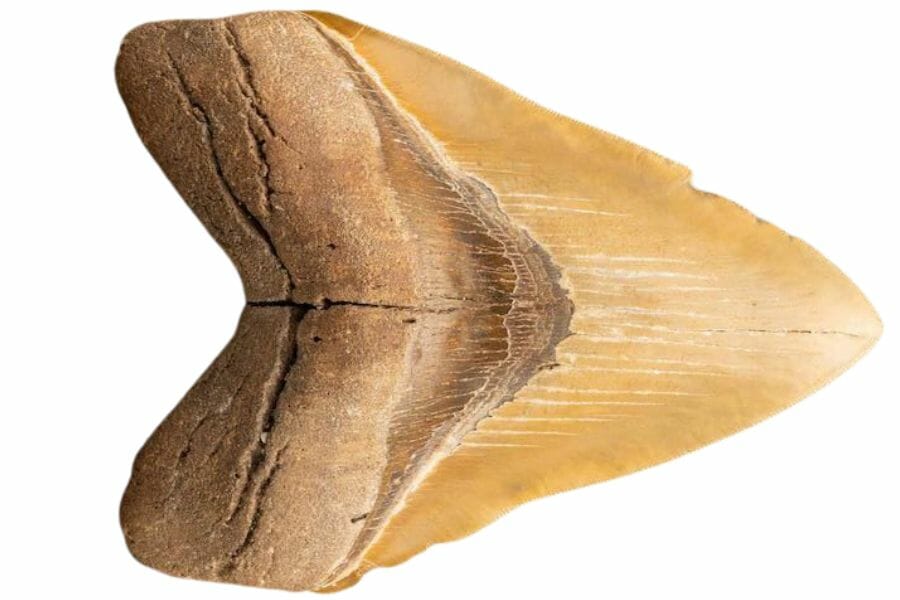Fossils are the remains or traces of ancient living things preserved over time. They can be as small as a grain of sand or as large as a dinosaur bone. Despite how amazing they are, finding these natural treasures anywhere isn’t a walk in the park, especially if you’re looking for Florida fossils.
Sometimes, they’re hidden deep in the earth or in places hard to reach. Without the right guidance, it can be like searching for a needle in a haystack.
If you’re wondering where to start finding fossils in Florida, you’re in luck because we’ve found some incredible spots we’re going to share! Over the years, many amazing fossils have been found here.
In this article, we’ll share with you our favorite sites where you can find both rare and common fossils in Florida. With a little patience and some digging, you can surely successfully find them here. Let’s start hunting!
The Fossils Of Florida You Can Find
Aside from being endowed with many great rockhounding spots, Florida also has it all— from ancient shark teeth to the bones of giant creatures like mammoths. If you want to uncover them, there are certain specific areas you should explore.
But before we get into the details of these favorite sites for fossil hunting in Florida, let’s first discuss the different rare and common fossils that you can find here:
- The extensive local experience and understanding of our team
- Input from multiple local fossil hunters and fossil groups
- The accessibility of the various locations
- Safety and potential hazards when collecting
- Private and public locations
- A desire to include locations for both experienced fossil lovers and those who are just starting out
Using these weights we think we’ve put together the best list out there for those who love finding great new fossils for our collections!
Common Florida Fossils
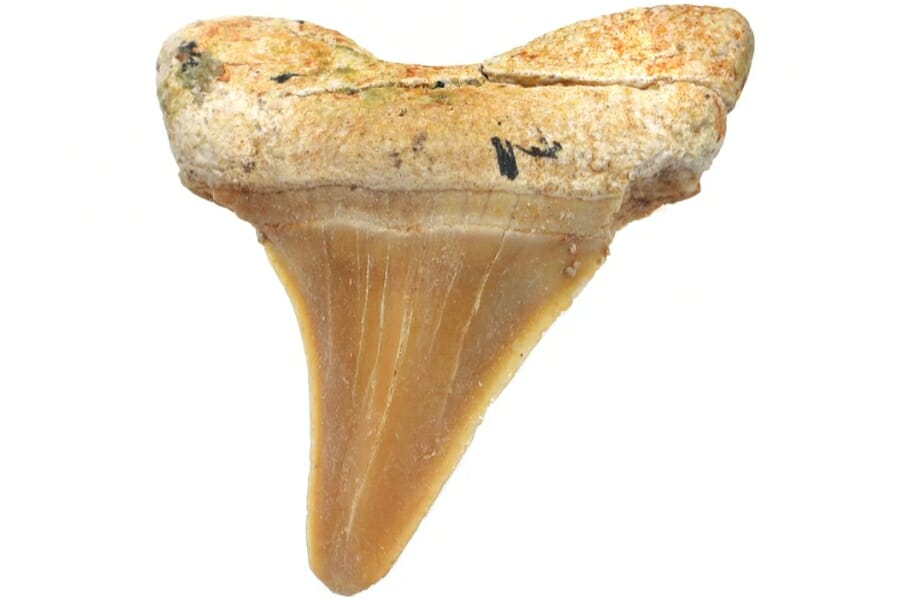
When you hunt Florida fossils, below are some of the most common ones that you might find:
- Shark teeth
- Coral
- Bryozoans
- Brachiopods
- Foraminifera
- Echinoid
- Ivory
- Glyptodonts
Florida State Fossil – Agatized Coral
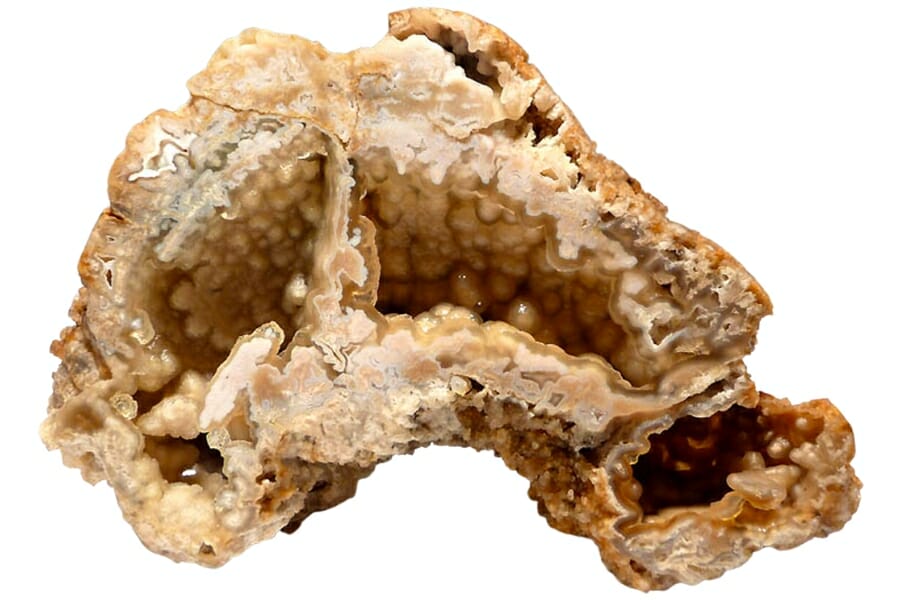
Agatized coral is a coral, which is usually soft, that turned into a colorful, solid rock over millions of years. What makes it super special is its unique patterns and colors. Each piece looks different: Some might have bands of color, while others showcase the intricate structures of the original coral.
Florida recognized this amazing gem in 1979 because it tells a story of our state’s ancient underwater past. Many of these fossils are found in areas that were once covered by seas millions of years ago.
Rare Florida Fossils
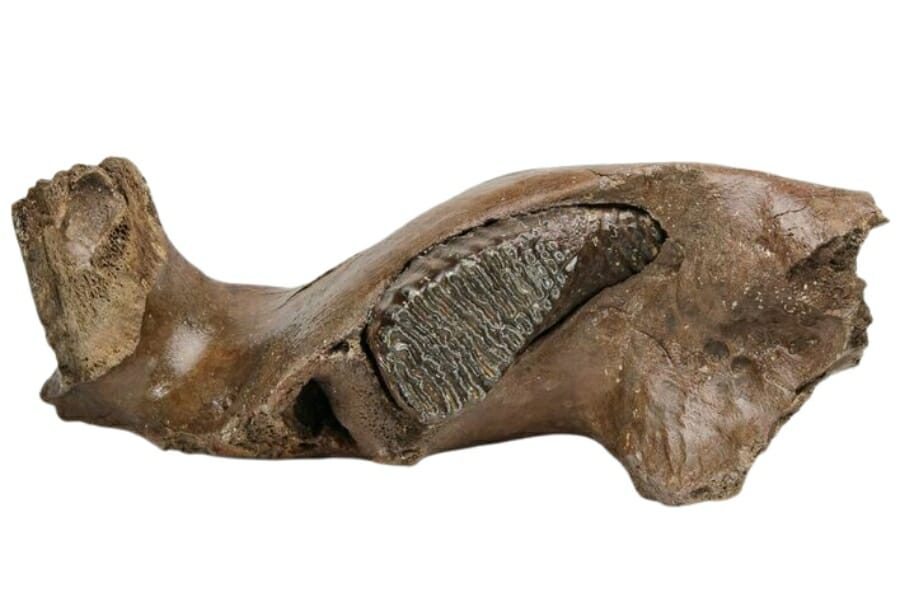
Aside from the command finds, we also have incredibly valuable rare Texas fossils. Below are some of them, so you can research about them ahead of your fossil hunting trip here:
- Megalodon Teeth
- Mammoth
- Mastodon
- Giant Ground Sloths
- Windover People Bones
The Best Places To Find Fossils In Florida
Below are our favorite sites to uncover fossils in Florida, including details you’ll need to know about them before you visit them. We highly recommend prioritizing exploring these spots:
Always Confirm Access and Collection Rules!
Before heading out to any of the locations on our list you need to confirm access requirements and collection rules for both public and private locations directly with the location. We haven’t personally verified every location and the access requirements and collection rules often change without notice.
Many of the locations we mention will not allow collecting but are still great places for those who love to find beautiful rocks and minerals in the wild without keeping them. We also can’t guarantee you will find anything in these locations since they are constantly changing.
Always get updated information directly from the source ahead of time to ensure responsible rockhounding. If you want even more current options it’s always a good idea to contact local rock and mineral clubs and groups
Peace River (Bone Valley)
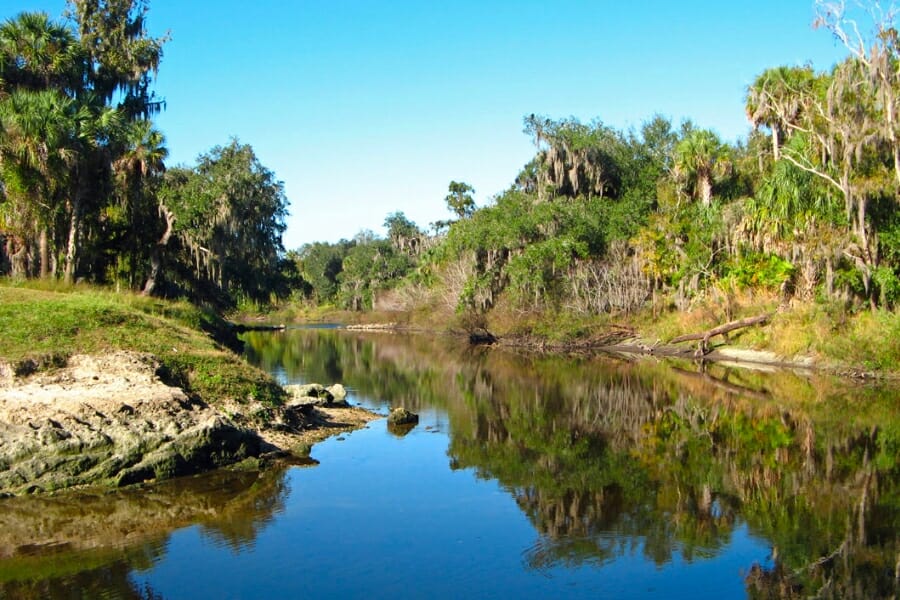
Flowing for over 100 miles through the heart of Florida, the Peace River winds its way through ancient lands that have been home to incredible creatures throughout history.
Its surroundings are a sight to behold, with cypress trees stretching their long limbs over the water, creating a peaceful canopy. The gentle flow of the water combined with our state’s warm sun makes it a perfect spot for an adventure.
For millions of years, Florida was covered by a shallow sea. Over time, the remains of marine creatures, plants, and even mammoths and giant ground sloths got buried. As the river’s water eroded the land, these hidden treasures started to resurface.
Peace River is easily accessible from major cities like Tampa and Orlando. Many spots along it, such as the popular Paynes Creek Historic State Park, offer easy entry for canoes and kayaks. Its shallow water and sandy bottom make it simple for anyone, even beginners, to wade in and start their fossil search.
Where and what fossils to find in Peace River
You can find Ice Age animal fossils here, such as fossils of tiger, hemi, megalodon shark teeth, alligator teeth, dugong bones, mammoths, dire wolves, glyptodonts, horses, giant ground sloths, bison, llama, beaver, tapir, dolphin, whale, barracuda, mastodon, stingray spines, and even bones of ancient camels!
If you want REAL results finding incredible rocks and minerals you need one of these 👇👇👇
Finding the coolest rocks in isn’t luck, it's knowing what to look for. Thousands of your fellow rock hunters are already carrying Rock Chasing field guides. Maybe it's time you joined the community.
Lightweight, mud-proof, and packed with clear photos, it’s become the go-to tool for anyone interested discovering what’s hidden under our red dirt and what they've already found.
Join them, and make your next rockhounding trip actually pay off.
What makes it different:
- 📍 Find and identify 140 incredible crystals, rocks, gemstones, minerals, and geodes across the USA
- 🚙 Field-tested across America's rivers, ranchlands, mountains, and roadcuts
- 📘 Heavy duty laminated pages resist dust, sweat, and water
- 🧠 Zero fluff — just clear visuals and straight-to-the-point info
- ⭐ Rated 4.8★ by real collectors who actually use it in the field
Venice Beach
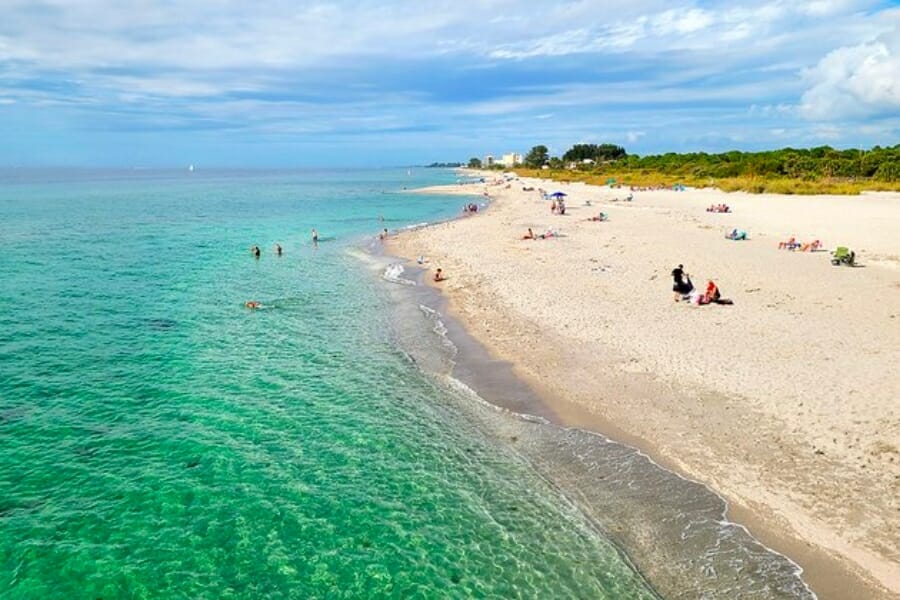
Venice Beach is often called the “Shark Tooth Capital of the World,” and for a good reason! With its golden sands stretching along the Gulf Coast, it’s a hotspot for finding ancient shark teeth.
In ancient times, its area was submerged underwater and was home to many sea creatures, including sharks. Over the years, as these sharks lost their teeth, the old teeth settled into the ocean floor. Fast forward to today, and the ocean waves have eroded the land, revealing them.
Reaching Venice Beach is straightforward. It’s situated on Florida’s west coast, not far from the city of Sarasota. The beach is well-marked and has ample parking for visitors.
Where and what fossils to find in Venice Beach
You can find shark teeth, ranging in size from tiny specks to the large teeth of the mighty megalodon, an ancient and massive shark if you beach comb here.
You can also find fossils of ray plates, dugong rib sections, whale jaw sections, and horse teeth here.
Florida Caverns State Park
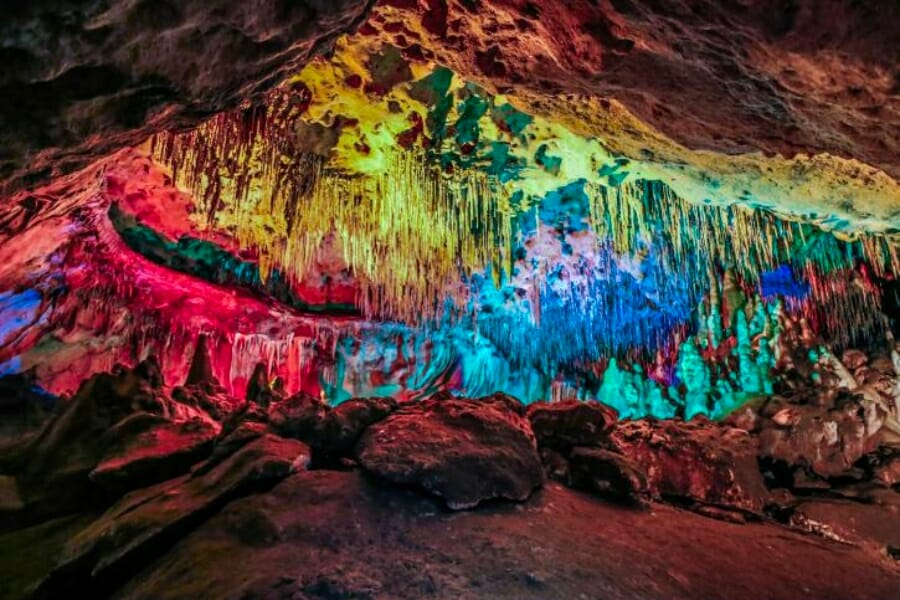
Florida Caverns State Park boasts the only open-air caves you can tour in our entire state. But it’s not just the caves that are special; the park is also a fantastic spot to learn about the ancient history of the region.
As you explore the caves, you’ll be greeted by stunning formations of limestone stalactites, stalagmites, and flowstones. In some spots within the park, you can find fossils of sea creatures that once lived in ancient seas that once covered this area.
Florida Caverns State Park is located just outside the town of Marianna, making it easily accessible from major highways. Once at the park, you can take guided tours of the main cave, where the guides point out any fossils embedded in the walls.
Where and what fossils to find in Florida Caverns State Park
You can find fossils of corals, bryozoans, brachiopods, nautilus (Aturia), echinoids, and foraminifera if you explore here.
Windley Key Fossil Reef Geological State Park
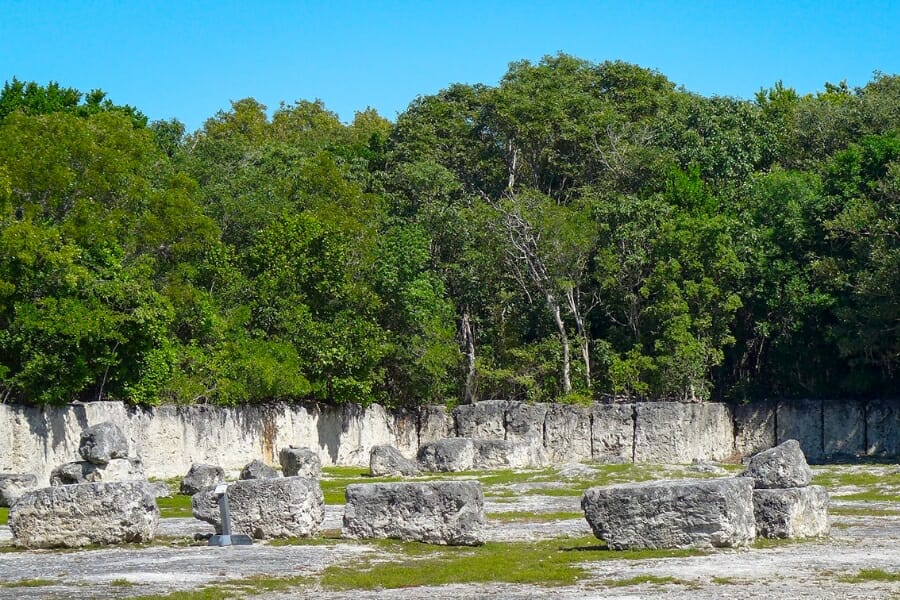
Located in the beautiful Florida Keys, the Windley Key Fossil Reef Geological State Park is home to an old quarry where you can see fossilized coral formations up close.
As you wander around, you’ll notice large boulders and walls showcasing layers upon layers of fossilized coral. These corals lived here about 100,000 to 125,000 years ago. Over time, the coral skeletons became part of the limestone rock, preserving their intricate shapes and patterns.
Visiting Windley Key Fossil Reef Geological State Park is easy. It’s situated right off the Overseas Highway in Islamorada in the Florida Keys. There’s a small visitor center where you can learn more about the park’s history, the fossils, and the quarrying activities that took place here.
Where and what fossils to find in Windley Key Fossil Reef Geological State Park
From brain corals that look like a maze to the delicate fans of sea fans, you can see fossils of corals from the Pleistocene age preserved in big 8-foot-tall rock walls, just like they were when they died!
You can also find a 2-inch long imprint of Lithophaga, a stone-eating mollusk when you visit here.
Amelia Island

Amelia Island has beautiful beaches, rich history, and the thrill of fossil discoveries. Its shores are lined with golden sands, and the gentle waves from the Atlantic Ocean kiss the coast, making it an ideal spot to relax and explore.
But here’s the exciting part for fossil enthusiasts: Amelia Island’s shores are known for ancient shark teeth! These fossils, ranging from tiny black or brown specks to larger, more defined shapes, give us a peek into the marine life of ancient times.
While shark teeth are the most common finds, if you’re super lucky, you might also discover other marine fossils or even fragments of old shipwrecks.
Located just a short drive from Jacksonville, Amelia Island is easily accessible by car. Once you’re here, there are plenty of places to park near the beaches. The best times to look for fossils here are after a storm or during low tide.
Where and what fossils to find on Amelia Island
If you go beachcombing through Amelia Island’s shores, you can find shark teeth lying on the ground.
Other Top Places To Find Florida Fossils By Region
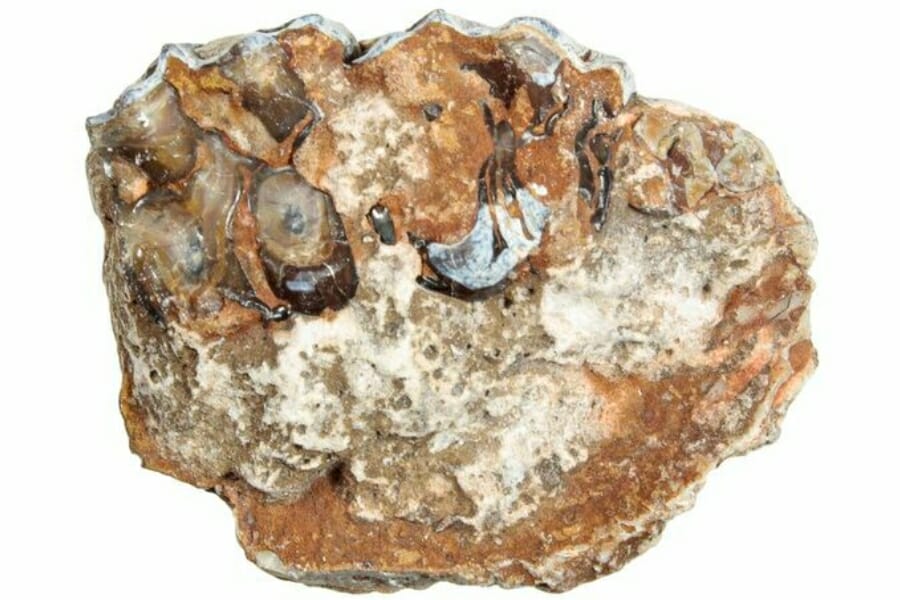
As a fossil hunter’s wonderland, it should come as no surprise that Florida has other sites that you can explore for these natural wonders. We’ve listed them down below, including what specific fossil you may find in each of them:
| Location | Fossils |
| Excavations, road, and railroad cuts countywide in Alachua County | Ivory |
| Brevard Museum of History and Natural Science in Brevard County | Windover people bones, Bird bones |
| Spoil mounds of Charlotte County Department of Transportation | Marine invertebrates |
| Excavations, road, and railroad cuts countywide in Citrus County | Ivory |
| Limonite quarries countywide in Citrus County | Ivory |
| Inactive limestone quarry of GTE Satellite Systems Corporation in Citrus County | Marine invertebrates |
| Quarry and spoil piles south of Cross-Florida Barge Canal in Citrus County | Marine fossils |
| South from below the bridge of Port of Miami in Dade County | Coral fossils |
| Havana area fuller’s earth mines in Gadsden County | Invertebrate and vertebrate fossils, varied shells and bones, Ivory |
| Hinson area abandoned fuller’s earth mines in Gadsden County | Invertebrate and vertebrate fossils, varied shells and bones, Ivory |
| Jamieson area fuller’s earth mines in Gadsden County | Invertebrate and vertebrate fossils, varied shells and bones, Ivory |
| Quincy area fuller’s earth mines in Gadsden County | Invertebrate and vertebrate fossils, varied shells and bones, Ivory |
| Quarries countywide in Gilchrist County | Agatized corals |
| Jasper area phosphate mines in Hamilton County | Coral geodes |
| White Springs area phosphate mines in Hamilton County | Coral geodes |
| Suwannee River and both sides of its tributaries in Hamilton County | Coral heads |
| Brooksville area excavations, road, and railroad cuts in Hernando County | Echinoid geodes with crystal interiors |
| Brooksville area quarries in Hernando County | Echinoid geodes with crystal interiors |
| Dredging or deep-digging construction operations countywide in Hernando County | Marine invertebrates |
| Exposed tidal flats during low tide at Bayshore Boulevard and Interbay Boulevard in Hillsborough County | Coral geodes, Shells |
| Hillsborough River bank streams in Hillsborough County | Coral geodes, Silicified brain corals, and finger corals |
| Shores of Davis Island, especially at Ballast Point in Hillsborough County | Corals |
| Limestone quarries countywide in Jackson County | Shells |
| Quarries countywide in Lafayette County | Coral geodes, Agatized shells |
| Quarries countywide in Levy County | Coral geodes, Shells |
| Gulf Hammock quarry in Levy County | Bryozoans (excellent quality), Gastropods, Echinoids, Corals, Shark Teeth |
| Excavations, road, and railroad cuts countywide in Marion County | Ivory |
| West at Bailey’s Bluff in Pasco County | Coral |
| New Port Richey area quarries and other excavations in Pasco County | Coral geodes, Shells |
| Northern half of Sand Key in Pinellas County | Corals |
| Tidal flats of Honeymoon Island at the west end of Caladesi Causeway in Pinellas County | Coral geodes, Shells, Silicified coral fingers |
| Tarpon Springs area in Pinellas County | Coral |
| Phosphate mines in the Lake Hookers Prairie area in Polk County | Bones, Mastodon teeth, Ivory, Shark Teeth |
| Phosphate digging operations countywide in Polk County | Bones, Mastodon teeth, Ivory, Shark teeth |
| Phosphate mine in Fort Fort Meade area in Polk County | Bones, Mastodon teeth, Ivory, Shark teeth |
| Wear Ranch in Kathleen area, Polk County | Coral fossils |
| Around the I-4 interchange in Lakeland area, Polk County | Coral fossils |
| Phosphate mine in Saddle Creek, Polk County | Bones, Mastodon teeth, Ivory, Shark teeth |
| Phosphate mine in Lake Parker, Polk County | Bones, Mastodon teeth, Ivory, Shark teeth |
| Canal near Kathleen in Lakeland area, Polk County | Coral |
Common Questions About Fossil Hunting In Florida
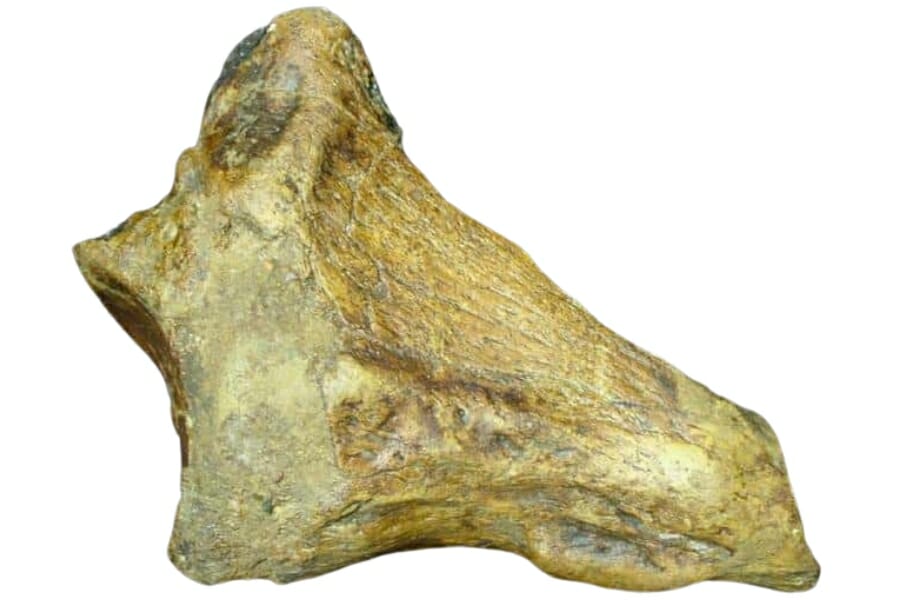
When folks go fossil-hunting in Florida, they often have similar common questions, and in this section, we’ll answer them for you:
Can you find megalodon teeth or shark teeth in Florida?
Florida is actually one of the best places in the world to find shark teeth, including those of the mighty megalodon. Our state’s geological history and ancient marine environments make it a prime location for these fossilized treasures.
Places like Venice Beach, dubbed the “Shark Tooth Capital of the World,” and Peace River are particularly renowned for frequent discoveries of shark teeth, including the occasional megalodon tooth.
Is it illegal to collect fossils in Florida?
It’s legal to collect fossils in designated collecting sites in Florida. For starters, make sure to obtain permission before exploring private land, while for public land, collecting is strictly forbidden.
For more information on our local collecting guidelines, visit the official website of the Florida Department of Environmental Protection.
Can you find dinosaur bones in Florida?
Interestingly, while Florida is known for a rich array of fossils, it’s not a hotspot for dinosaur bones. The reason for this is largely geological. During the time when dinosaurs roamed the Earth (from about 230 million to 65 million years ago), much of Florida was submerged underwater.
However, while dinosaur bones are rare, our state is rich in fossils from the Cenozoic Era, which came after the age of dinosaurs. These include ancient mammals, birds, reptiles, and especially marine creatures.
Our Favorite Places To Buy Fossils In Florida
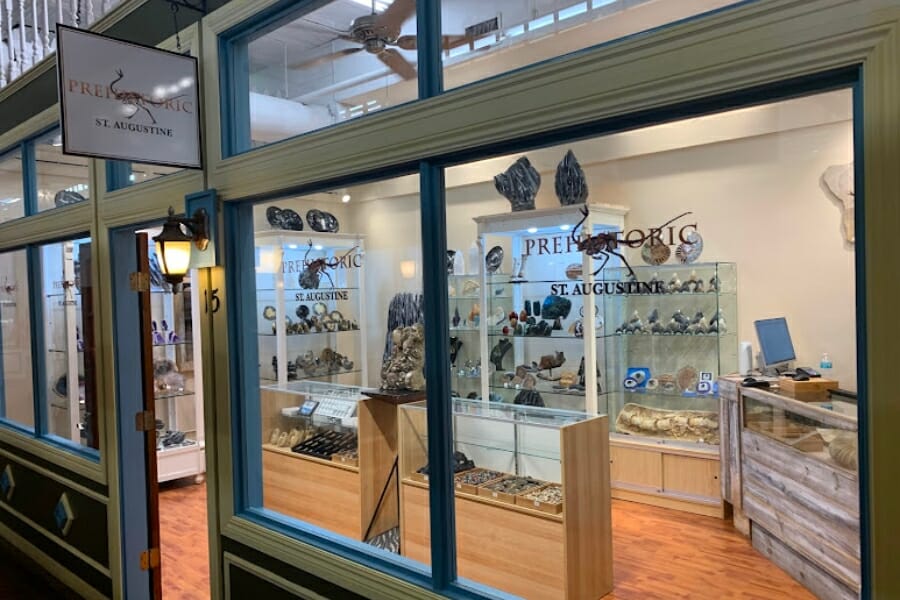
Another great way to see, touch, and even take home Florida fossils and those from other states is to visit our reputable local fossil shops. Below are some of our recommended ones:
- Ancient Artifacts & Treasures, Inc. – 1999 W Fairbanks Ave, Winter Park, FL 32789
- Darwin and Wallace: A Nature & Fossil Store – 1200 E Altamonte Dr. Suite 1010, Altamonte Springs, FL 32701
- Earth Treasures – 207 West Miami Ave W, Venice, FL 34285
- Paleo Enterprises – 1233 W Fairbanks Ave, Orlando, FL 32804
- Prehistoric Florida – 127 St George St, St. Augustine, FL 32084
- The Dinosaur Store – 250 W Cocoa Beach Causeway, Cocoa Beach, FL 32931

